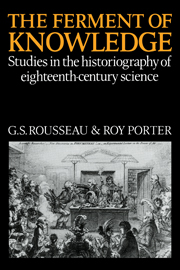Book contents
- Frontmatter
- Contents
- Contributors
- Acknowledgements
- Abbreviations
- Introduction
- PART I PHILOSOPHY AND IDEAS
- PART II LIFE AND ITS ENVIRONMENT
- PART III THE PHYSICAL WORLD
- 8 Mathematics and rational mechanics
- 9 Experimental natural philosophy
- 10 Chemistry and the chemical revolution
- 11 Mathematical cosmography
- 12 Science, technology and industry
- Index
8 - Mathematics and rational mechanics
Published online by Cambridge University Press: 03 May 2010
- Frontmatter
- Contents
- Contributors
- Acknowledgements
- Abbreviations
- Introduction
- PART I PHILOSOPHY AND IDEAS
- PART II LIFE AND ITS ENVIRONMENT
- PART III THE PHYSICAL WORLD
- 8 Mathematics and rational mechanics
- 9 Experimental natural philosophy
- 10 Chemistry and the chemical revolution
- 11 Mathematical cosmography
- 12 Science, technology and industry
- Index
Summary
Introduction
In most historical accounts of mathematics and mechanics, the eighteenth century is recognized as a separate period. But that recognition seems conditioned less by the characteristics of eighteenthcentury mathematical science itself, than by the fact that the eighteenth century straddles two exciting periods in the development of mathematics and mechanics: the seventeenth and the nineteenth centuries. The seventeenth century saw the creation of algebraical symbolism by Viète and Descartes, of analytical geometry by Descartes and Fermat, the beginning of a mathematical theory of chance through Pascal, Fermat and Huygens, the foundation of classical mechanics by Galileo, Huygens and Newton, and the invention of the calculus by Newton and Leibniz. And the nineteenth century witnessed the foundation of rigorous analysis through Cauchy and Weierstrass, the creation of complex function theory by Cauchy, Riemann and Weierstrass, the emergence of new schools in geometry, projective geometry and non-Euclidean geometry in the work of Poncelet, von Staudt and others, new extensions of mathematical physics in relation to the theory of heat and electricity, the creation of modern algebra through Galois, Dedekind and Kronecker, and the beginnings of set theory and foundational studies of mathematics in the works of Cantor.
Available historical accounts create distinct pictures of both these periods, with persons and achievements clearly placed in the foreground - images well structured in the common memory of the community of mathematical scientists. The eighteenth century does not enjoy such clarity.
- Type
- Chapter
- Information
- The Ferment of KnowledgeStudies in the Historiography of Eighteenth-Century Science, pp. 327 - 356Publisher: Cambridge University PressPrint publication year: 1980
- 51
- Cited by



